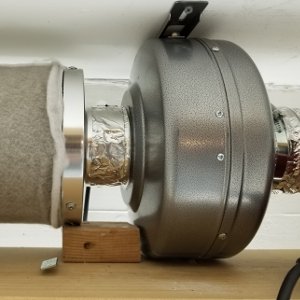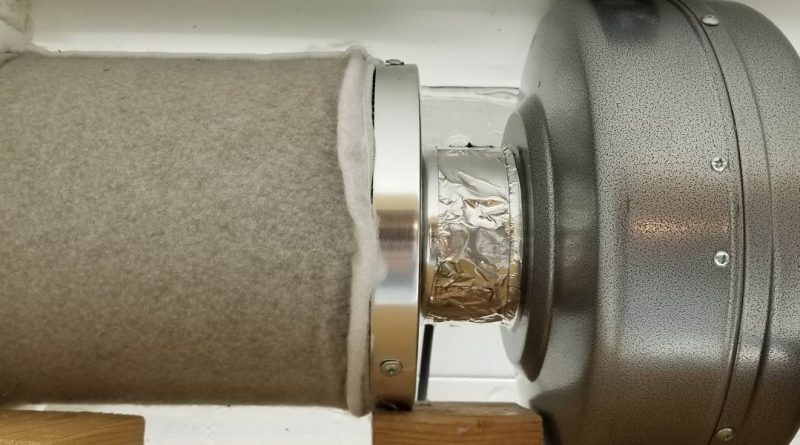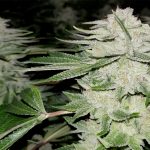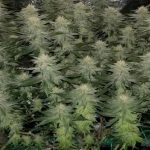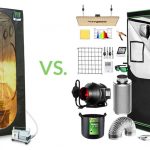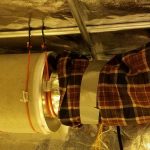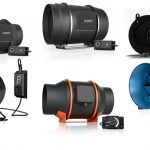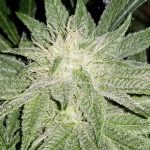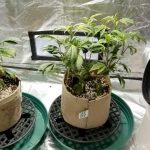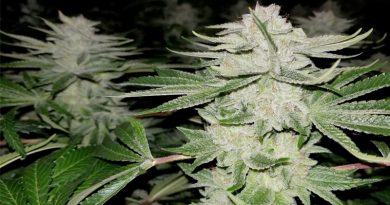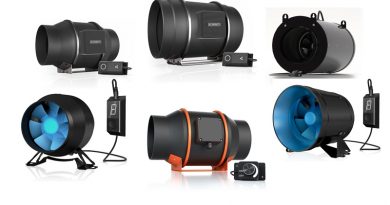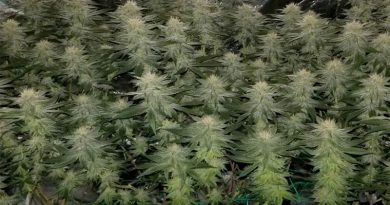Ventilation in weed grow tents: How much ventilation do I need?
If you’re setting up a weed grow tent, it’s important to consider how much ventilation you will need. We can help you determine the proper ventilation for grow tents to create the perfect environment so you can grow top-quality marijuana.
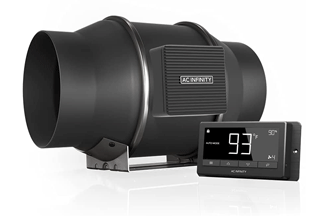
Grow tents require two types of fans:
- Ventilation fans remove humid, stale air and allow fresh air (and CO2) to enter. Most grow tents use inline fans in 4″, 6″, 0r 8″ sizes. Larger tents may also use a smaller intake fan to improve ventilation.
- Circulation fans move air around, but that’s a separate topic — learn more about what size fans are needed air circulation or read grow tent circulation fan reviews to find one that’s best for your needs.
Why is ventilation important in weed grow tents?
As weed plants process light into energy they release moisture. Proper exhaust ventilation in grow tents helps eliminate excess heat and moisture while supplying fresh air full and carbon dioxide (CO2).
Excess heat will damage cannabis plants and affect growth and bud production. Adequate ventilation is usually enough to control heat levels, and it also removes moisture that can otherwise lead to mold and powdery mildew problems. By the time you notice PM it’s too late, so take precautions to avoid disappointment later on.
How much ventilation is needed in grow tents?
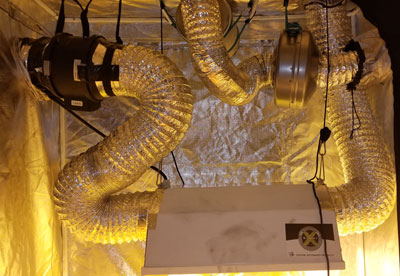
It’s important that you plan how much ventilation you need in your grow tent to create a growing environment where your marijuana plants can prosper.
Your goal is to be able to adjust the grow room conditions to as near perfect as possible for optimal marijuana growth, yield, and potency.
A digital thermometer and hygrometer is a must. Look for models that track lows and highs for both so you can understand the range that your plants experience when the lights are off. To low or high humidity or temperatures can lead to problems.
How to calculate the amount of exhaust ventilation needed in grow tents
How to choose the correct inline fan size for your grow tent/room
Inline fans used in grow tents to provide exhaust are rated by the volume of air they can remove. Air volume is measured in Cubic Feet per Minute, or CFM’s. The bigger the fan, the more air it can remove.
You should always buy a fan that is more powerful than you think you’ll need. It’s cheaper to spend a little more on a 6″ fan up front than to buy a 4″ fan and have to upgrade anyway.
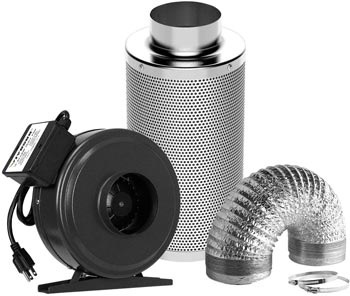
Look for models with multiple fan speeds. Since most of the less expensive inline fans used by marijuana growers are a single speed (100%), using a fan controller can give you control to reduce fan speeds. Learn how to select the right fan controller. Fan controllers reduce vibration and noise, another benefit.
How to calculate the volume of air in your grow tent
The proper amount of exhausted air depends on the volume within your tent. To calculate the volume of air to remove, multiply the height, width, and length of your grow tent which tells you the tent’s volume. Your goal is for your exhaust system to replace the air in your tent every one minuteto supply enough fresh carbon dioxide and to control moisture and temperature.
For example, if you use4x4x7 grow tent, you’d need to remove 112 CFM per minute. A 4x8x7 tent would need to remove 224 CFM per minute. But there’s more to it than that. You need to factor in how air moves through the exhaust vents.
Air resistance
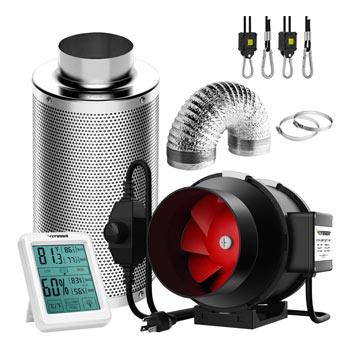
But that doesn’t necessarily mean you’d only want a fan rated exactly for the volume of your tent. You also need to take into account the efficiency of your vents themselves. Your venting setup can have a big impact on the actual amount of air your fan can remove.
Air encounters resistance when being fed through venting ductwork. Short, straight venting runs are more efficient than long runs or those with lots of curves. We’re not going to get into the math for how to calculate this resistance. Instead as a rough calculation you can just double the volume of your grow tent for short vent runs.
If you have a long run or lots of curves, you should plan to exhaust three times your tent’s volume each minute. For very long runs, plan to add a small duct fan which attaches to the other end of your duct run to provide additional help for your inline fan.
If your tent is using passive air intake via the small vents around the bottom, this can further increase air resistance and cause the tent walls to suck in.
Where to position exhaust fans in a grow tent

Since heat rises, exhaust fans should pull from the top of the tent. Air intake should come from tent openings at the bottom, either the tent vents or using an intake fan.
If you’re using a carbon filter, mount it on the ceiling with bungee cords or straps to absorb vibration. Use flexible aluminum ducting to connect it to the fan, which should be mounted outside of the grow tent. Seal with aluminum tape.
For tents using an air cooled light, you can use a single fan to push the air through the light hood and then out of the tent. You can also use a separate fan to cool the light, but this requires a tent with at least 3 duct openings at the top. Before you purchase a tent, make sure to fully consider the rest of your setup to ensure the tent openings meets your needs.
Never have your tent’s exhaust fans pull from the bottom of the tent, this will result in higher temperatures at the top of the tent. You want to draw the hot air out at the top and pull in cool air at the bottom, which will rise as it heats to the top. This cycle ensures a stream of fresh air across your plants, which is then pushed around by the circulation fans in your tent to avoid pockets of moist, stagnant air.
Automated ventilation controls
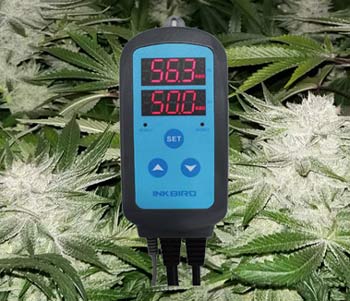
There are several ways that you can approach ventilation. Most small tent growers keep exhaust fans running all the time to keep introducing fresh air and to prevent heat or moisture buildup.
You can also purchase fan controllers that turn on or increase speeds when certain temperature and humidity levels are reached. Be careful to always remove stale air and humidity
Automated controls are also helpful when you are drying weed in a small tent. They allow you to maintain the perfect humidity range for a slow, steady dry.
Advanced growers run sealed rooms that supplement carbon dioxide directly to the plants. These rooms also utilize air conditioning for heat control, and large dehumidifiers for moisture control. Boosting CO2 lets you run your grow room a little hotter, and produces great results. Ventilation isn’t required in sealed room setups.
Reducing noise from vent fans and vents

Exhaust systems using powerful inline fans can be quite noisy.
There are several approaches to quieting fans and the noise of moving air, including fan controllers, insulating your ducts, mounting equipment using bungee cords, and exhaust mufflers.
The best tip to reduce fan noise is to use a controller to run a larger fan at a lower speed. Buying a larger fan is also allows you to scale up the size of your grow and avoid the need to repurchase equipment.
Learn how to pick the best fan controller to slow down fans and reduce wind noise. If having a quiet stealthy grow is important to you, get more details on how to reduce noise from inline fans within grow tents.
Summary
Proper ventilation in grow tents for marijuana in creating a proper environment to maximize the quantity, quality, and potency of your grow. With a little bit of equipment your can provide the perfect conditions to grow great marijuana indoors.
Ventilation will let you control temperature, humidity, and the intake of fresh air while reducing the chances of unwanted mold, pests, or disease. Monitor your grow closely and take precautions to avoid trouble down the line.
